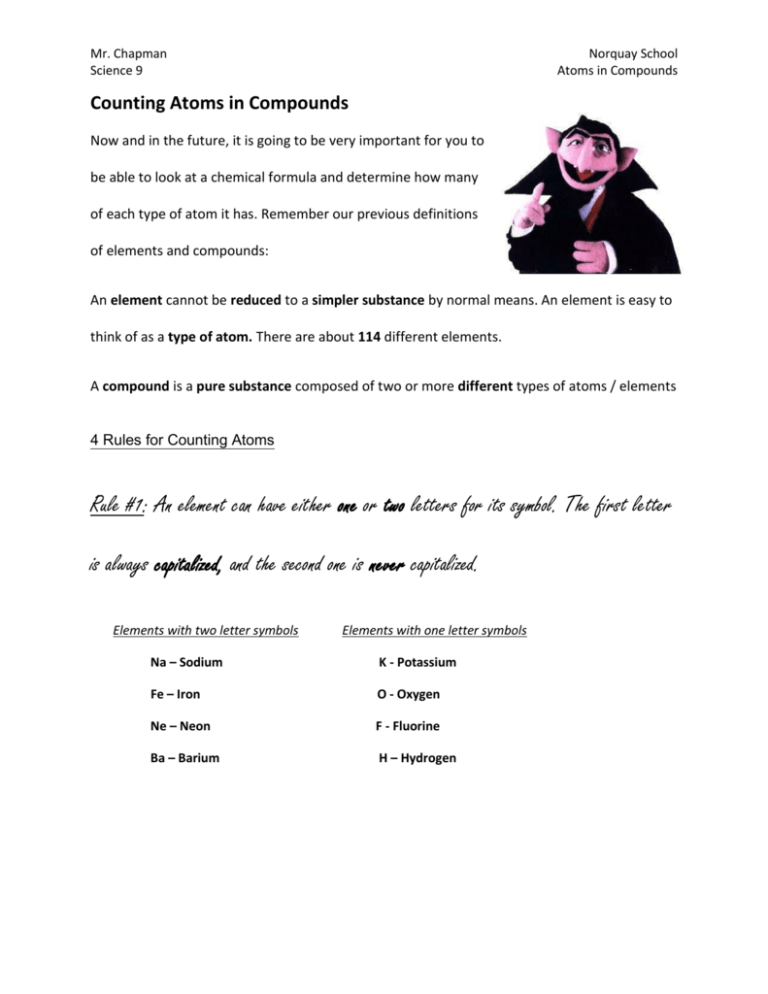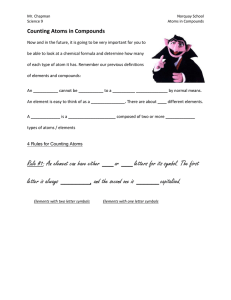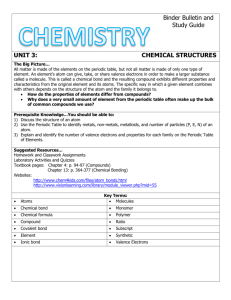Counting Atoms in Compounds
advertisement

Mr. Chapman Science 9 Norquay School Atoms in Compounds Counting Atoms in Compounds Now and in the future, it is going to be very important for you to be able to look at a chemical formula and determine how many of each type of atom it has. Remember our previous definitions of elements and compounds: An element cannot be reduced to a simpler substance by normal means. An element is easy to think of as a type of atom. There are about 114 different elements. A compound is a pure substance composed of two or more different types of atoms / elements 4 Rules for Counting Atoms Rule #1: An element can have either one or two letters for its symbol. The first letter is always capitalized, and the second one is never capitalized. Elements with two letter symbols Elements with one letter symbols Na – Sodium K - Potassium Fe – Iron O - Oxygen Ne – Neon F - Fluorine Ba – Barium H – Hydrogen Mr. Chapman Science 9 Norquay School Atoms in Compounds Rule #2: When looking at a chemical formula, you will sometimes see small numbers written beside some elements. These numbers are called subscripts, and they represent how many of that atom is present in the chemical formula. Example: The chemical formula for water is H2O. There are two elements in water, one is Hydrogen (H), and the other is Oxygen (O). In water there are 2 hydrogen atoms and 1 oxygen atom. You can tell this by the subscripts that are on the right of each atom. If there is no subscript, the number is assumed to be a one. Identify each type of element and the number of atoms of each type in the following: 1. NaCl Sodium (1) Chlorine (1) 2. SO2 Sulfur (1) Oxygen (2) 3. LiHCO3 Lithium (1) Hydrogen (1) Carbon (1) Oxygen (3) Mr. Chapman Science 9 Norquay School Atoms in Compounds Rule #3: If some chemical formulas, there are brackets. There is always a subscript outside of the bracket. To count the number of atoms in these formulas, multiply the number outside the brackets by everything inside the brackets. Examples: Identify each type of atom, and count the number of each in the formula. 1. Ba(OH)2 Barium (1) Hydrogen (2) Oxygen (2) 2. Mg(NO3)2 Magnesium (1) Nitrogen (2) Oxygen (6) 3. Al2(SiO3)3 Aluminum (2) Silicon (3) Oxygen (9) Super Tough Challenge: Pb(CH3COOH)3 Mr. Chapman Science 9 Norquay School Atoms in Compounds Rule #4: If some reactions, you will find a number in front of the formula. This number is called a numerical coefficient. Multiply each atom in the formula by the number in front of the chemical formula. Examples: Identify each type of atom, and count the number of each in the formula. 1. 2 NaNO3 Sodium (2) Nitrogen (2) Oxygen (6) 2. 5 MgBr2 Magnesium (5) Bromine (5) Ultra Challenge: 5 Ge(SiO3)3









